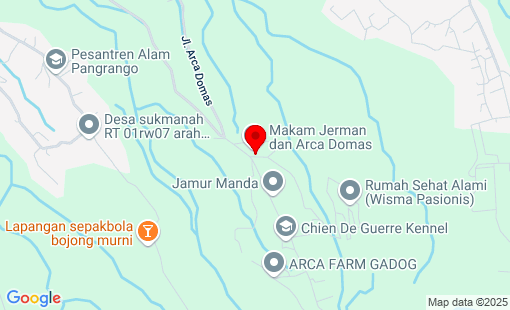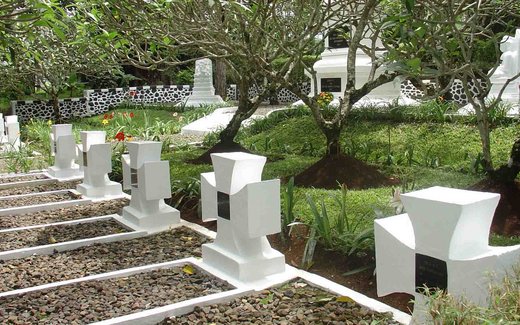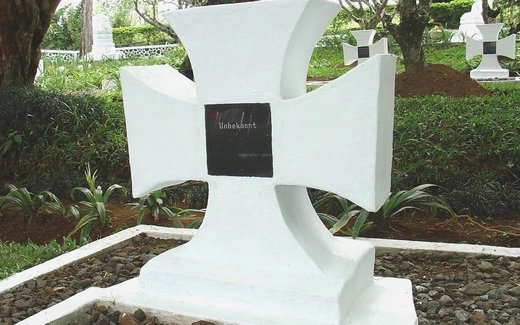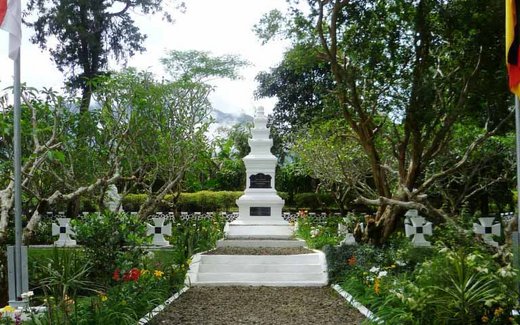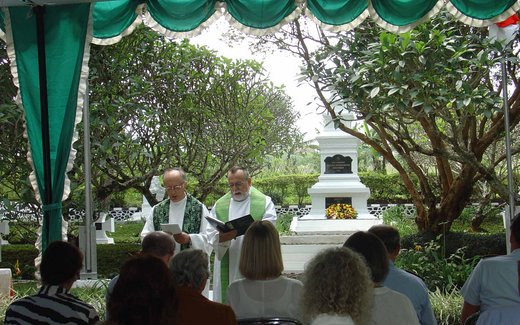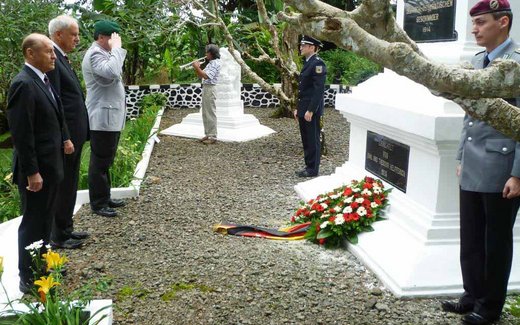Indonesia
Arca-Cikopo-Selatan
Total Occupation: 10 fatalities
Total Occupation: 10 fatalities
Open all year round
In the Arca Domas cemetery you will find 10 graves of German soldiers, 2 of which are unknown, who all lost their lives through illness or violence in the turmoil after the end of the Second World War. They had come here on board submarines that were supposed to transport vital raw materials for the German navy from the then Japanese-occupied Indonesia through the Allied naval blockade of Germany. Many sailors paid with their lives for this seemingly desperate plan by the German naval command. Every year on Remembrance Day in November, the ambassador and his military attaché lay a wreath there for the victims of war and tyranny. Afterwards, an ecumenical service is regularly held by the German-speaking Catholic and Protestant parishes. The cemetery is located at an altitude of around 1,000 meters near the town of Bogor in the village of Cikopo, around 70 kilometers south of Jakarta. The access road is asphalted except for the last few kilometers. The grounds are looked after and maintained by the Embassy of the Federal Republic of Germany in Jakarta. Source: German Embassy Jakarta Photographs: Herwig Zahorka 1. side view with the eight graves marked by name and the main monument in the background, which is flanked by a Buddha statue on the right and a Hindu Ganesha statue on the left.2. annual wreath-laying ceremony, from left: retired forestry director Zahorka, the ambassador and the defense attache.3 plaque at the entrance to the cemetery.4 One of the two graves with "Unknown".5 View up the terraces to the main monument.6 Annual ecumenical prayer with the German community. The story On the slopes of the Pangrango volcano in West Java, at an altitude of almost 1000 meters, ten white gravestones stand between huge Waringin trees. They are shaped like iron crosses. Eight have a name plate, two say "Unknown". They are the final resting places of young sailors who came here underwater during the Second World War, on adventurous voyages in their submarines. They rest in historically sacred ground. Once upon a time there were Sundanese kingdoms here in West Java. The dynasties of Hindu kings from Tarumanagara to Pajajaran ruled over their Sundanese people with their Hindu high priests for over 1000 years. For centuries, the souls of the deceased were handed over to the gods in a sanctuary on the slopes of the Pangrango volcano. Four sacred Waringin trees (Ficus sp ) surrounded this terraced sanctuary. The carved statues and stones numbered around 800 and the cemetery was called Arca Domas (c=tsch), which means eight hundred statues in Old Sanskrit. From 1527, Islamic warriors under Fatahillah destroyed the Pakuan-Pajajaran kingdom and converted most of the Sundanese to Islam. The palaces and temples were lost. The priesthood possibly fled to a remote mountain range and successfully shielded themselves against all outside influences to this day. No foreigners are allowed to enter the inner territory of this ethnic group known as "Kenekes" or "Badui", where there is also an Arca Domas sanctuary. Over time, most of the stones were used to build houses. In 19th century lithographs, many statues show features of the Polynesian style, as can also be seen in the National Museum in Jakarta. The slope was later cultivated for agriculture. After the First World War, the German brothers Emil and Theodor Helfferich bought 900 hectares of land here and ran a profitable tea plantation with its own tea factory and transport cable car. Comfortable buildings were erected in the pleasant climate zone at around 900 m above sea level. As their elder brother Karl Helfferich was Vice-Chancellor under the last German Emperor, they erected a monument between the venerable trees with the inscription "To the brave German East Asia Squadron 1914, erected by Emil and Theodor Helfferich" in solidarity with the Imperial Navy and in memory of Admiral Graf Spee's East Asia Squadron, which was sunk by the British. As a tribute to the ancient religions of Java, the monument was flanked by a statue of Buddha and a statue of Ganesha, the Hindu deity of wisdom with the head of an elephant. The inauguration took place in 1926 on the occasion of the visit of the German school cruiser "Hamburg" to the then Dutch colony. A young lieutenant captain, Hans-Georg von Friedeburg, described this ceremony in his wonderful book "32,000 nautical miles on blue water". He later made it to Admiral General and ended his life in 1945 on the occasion of the German surrender. The Helfferich brothers returned to Germany in 1928 and left the technical management to Albert Vehring from Bielefeld. He had already brought plantation experience with him from New Guinea. His name will remain fatefully associated with Arca Domas. Start of the Second World War In 1939, the Second World War broke out and on May 10, 1940, German troops invaded the Netherlands. On the same day, the Dutch colonial administration began interning all 2,436 Germans. Most of them were members of the colonial administration with their families, such as plantation experts, engineers, doctors, scientists and oil experts. But there were also diplomats, many missionaries, merchants and sailors and some artists, such as the founder of the famous Balinese school of painting, Walter Spies. The largest camp was in North Sumatra. The men were separated from the women and children. Thanks to the Helfferichs' mediation, several hundred women and children were later able to leave for Japan via China, including Albert Vehring's wife Hildegard. Helfferich's plantation was expropriated. The downfall of the Van Imhoff and the "Free Republic of Nias "On December 14, 1941, Japanese troops landed on Borneo and in February 1942 in Air Bangis on Sumatra. The Dutch decided that the German men must not fall into their hands, because Germany was allied with Japan. The Dutch colonial administration therefore decided as early as January to ship the internees to the British Crown Colony of India. Two Dutch prison ships set sail from Sibolga on Sumatra on January 17th. On the 18th, the third was the 3000 GRT steamer of the Niederl. Königliche Paketfahrt Gesellschaft KPM "VAN IMHOFF" under Captain Bongvani. However, the ship was ordered to return after a few hours to pick up more Germans. in the end, 477 Germans, including Albert Vehring and Walter Spies, were crammed into dungeons one meter high and surrounded by barbed wire. They were guarded by 62 armed Dutchmen. The crew comprised a further 48 men. The ship was not marked with the Red Cross symbol. The next day, the ship was attacked on the high seas by a Japanese fighter plane. Two bombs exploded in the water, the third hit the ship lek. The first officer came to the Germans and explained that the ship was not in danger, but they had radioed for help anyway. There was no panic behind the barbed wire, but the Germans were dismayed when they saw through the barbed wire-covered vistas that the Dutch were launching the five large cargo boats, hooking them to a motor pinasse and leaving the ship for Sumatra. Each of these five-ton boats could have held 80 men, the motor pinasse another 60. Some of these boats are almost empty. Now the Germans broke open their prisons and realized that the ship was sinking. They discovered that the Dutch had also smashed the pumps and the radio equipment. There was still a small lifeboat on the stern, which the Dutch could not get out of the stuck cramps. The Dutch had broken the oars. The boat was marked for 42 men. With combined forces, it was freed and launched. 53 men threw themselves in. Using planks as oars, they pulled away for safety reasons. About 200 men had already jumped into the water in the hope of being rescued. But the fish killed by the bombs had attracted many sharks, which now attacked the helpless men. Some committed suicide. The most energetic quickly built rafts from hatches, boards and ropes. Albert Vehring's acquaintance found a hidden 2 to 3 meter long rowing boat on deck. 14 men squeeze in, Vehring takes command. The edge of the boat protrudes a hand's breadth out of the water. When they are 100 meters away from the ship, it suddenly sinks. With around 200 men still on board, the two boats and the rafts attempted to reach the island of Nias, 55 nautical miles off Sumatra. The next morning, January 20, the Dutch motor vessel "BOELOENGAN" appeared. It came within 100 meters of Vehring's boat. It was called out: "Are you Dutch?". When they replied in the negative, the Boeloengan turned away and disappeared. This meant that the men on the rafts no longer had a chance of being rescued. A Jewish jeweler who had fled Nazi Germany swam from his raft to the ship, but was mercilessly turned back. This was his undeserved death sentence. Albert Vehring later reported on these unbelievable events in an affidavit to notary Bernhard Grünewald in Bielefeld on June 20, 1949 (document roll no. 61/1949). He described how, in heavy seas, half of the men had to go overboard and hold on to the boat from the outside in order to lighten the load. The rafts could not be saved, however, and it was not until the fourth day, January 23, that they reached the cliffs of Nias, completely exhausted, starving, dehydrated and sunburnt. The larger boat was overturned by the surf, killing one man. A 73-year-old man hanged himself in despair. The next morning, the friendly Niassians and a Dutch pastor named Ildefons van Straalen provided the rescued men with food and drink. 411 German civilian internees perished in this disaster, including 20 Protestant and 18 Catholic missionaries as well as the brilliant artist Walter Spies. 67 men reached Nias, 65 of whom survived. As the "VAN IMHOFF" belonged to the Dutch KPM and the Netherlands was under German occupation, the insured operators had to pay compensation of 4 million guilders to the relatives of the dead in Germany, which was also unprecedented during a war. After the war, Walter Spies' parents, who were living in England, filed a lawsuit against the captain of the "VAN IMHOFF" Bongovan. He was sentenced to death, but was immediately amnestied. The next day, the survivors on Nias were recaptured by the Dutch and taken to the island's main town, Gunung Sitoli. There they were locked up in the police prison, which was guarded by Dutch and Indonesian policemen from Sumatra. The Indonesians were very surprised that they were now supposed to guard Germans, when the Germans had only recently defeated their unloved colonial masters in Holland. Albert Vehring plotted with them. The Germans allied themselves with the Indonesians and took the Dutch prisoners on Palm Sunday 1942. The Japanese had already landed on Sumatra and Java and - ironically - had now locked up the Dutch in internment camps everywhere. Now an unbelievable production took place on Nias that makes us smile today: The Germans, together with the Niassians, proclaimed the "Free Republic of Nias". The representative of the Bosch company, a Mr. Fischer, became their prime minister, and Albert Vehring became foreign minister. They had Niassian counterparts. The Niassans rejoiced, they had finally shaken off the colonial yoke. For a few weeks, the Germans ruled their island in agreement with the Niassians. Albert Vehring then sailed over to Sumatra to make contact with the Japanese. They arrived on Nias on April 17 and transported the Dutch prisoners, including Pastor van Straalen. The Germans were able to return to their former places, the "Free Republic of Nias" had dissolved again. Albert Vehring worked for the Japanese in a hotel, brewed schnapps and found himself back in Singapore as a ship's engineer. source: Herwig Zahorka
